We’ve got the power – for most things in our travel trailer, most of the time. We’ve also got some limitations. That’s OK; it’s normal for an off-grid mobile unit to be limited on energy usage in various ways. Now add the fact that we removed one energy source (burning propane) and we’re in the middle of an experiment into “what is possible”.
We like experiments, which is good because we have been doing a lot of them lately (some planned, some not) and will continue to run more of them. This is kind of the heart of this project, to try things, see what works and what doesn’t, and report on the results. Our style of living tends to be flexible and the idea of living inside an experiment actually makes a weird sort of sense.
External conditions change all the time, so there is a lack of control on some of the experiments, especially when it comes to energy generation. We’re powering as much as possible off of the sun’s rays, and the availability of rays changes frequently. Day to night, sun to clouds, trees overhead to open sky, warm to cold, season to season.
John put as much solar on the roof as he could fit. He installed a fairly large lithium battery bank (although it seems we could perhaps handle an additional set of similar size). When “mobility” is one of the main requirements, we have some limitations on system size and weight. Future efficiency improvements could certainly help.
As of today (May 2020) we have been fully electric since last September. Here’s a summary of the past months:
– Most of the time we have plenty of energy available for everything we do – refrigeration, cooking, charging devices, running appliances, lights, fans, etc.
– The refrigerator is the biggest constant power draw. I’ve got more details in the “nitty-gritty” section below.
– Water heating can use a small chunk, but we’re refining our manual control of the water temperature and we don’t turn it on longer than necessary. The default cutoff temperature is much higher than we need. A project around controlling the water heater cutoff (based on temperature) might be interesting and imminent.
– Air heating is definitely a big power draw, bigger than our system can handle for more than a couple hours on just the batteries + solar. We expect the new heat pump will have similar requirements. Hopefully the dehumidifier setting doesn’t draw too much. The air conditioner has the advantage of summertime, with longer daylight hours and higher sun overhead. So we’ll see about that. The trailer could stand to have some better insulation, no doubt.
Air temperature control is the one thing that will likely cause us to plan around being plugged in when the temperature is on the more extreme side. As we start getting better data (solar, usage numbers) we will have more details to report.
– When the weather turns cloudy/rainy, we adapt by lowering our energy usage. The inverter can be turned off at night and when we’re not at home. More energy-intensive cooking can be planned around sunshine. I’m learning to monitor the forecast in addition to the current battery level.
We haven’t been truly tested yet in a situation with multiple cloudy days in a row but with mild temperatures. We’ve had cold and dreary days when we plug in so we can run the heaters. We’ve had great temperatures with at least some sun at least every second or third day to recharge the batteries. Since I started tracking it, we’ve gone over a month without being plugged in. So I probably just jinxed us. I’ll let you know!
The refrigerator is the main point of focus in terms of not letting the batteries run out of juice. Keeping food cold is probably a good idea. All other critical items use very little energy and we could live a long time on one full battery charge without incoming solar if not for the fridge.
Luckily, even a cloudy day usually provides enough solar to run the fridge, so it’s only overnight that the fridge brings the battery level down. Typically the battery drops about 10 percentage points overnight (with the inverter off). What would happen if it rained for a week straight?
I don’t have an exact sense of how long we might be able to last without a good sunny charging day, without plugging in, if we were super careful to limit things that we turned on. Maybe 3-4 days? Maybe more? This is something we’ll work on understanding better.
So that’s the story. Now for some numbers. And a few photos.
There are two types of numbers:
– Power (in watts); how much is being used at that moment
– Energy (in watt-hours); how much is used in total over time
Starting with the power calculations, the most basic limit is 30 amps. Regardless of power source (grid or batteries), the 120-volt AC system can handle up to 30A before we start tripping breakers. Most of the instantaneous power calculations revolve around AC appliances like heaters, and there are additional limits of 15-20A on various sets of outlets. 30A x 120V AC = 3600 watts that we can use at any one time.
We need to be aware of this limit when cooking breakfast, for example. The air heater, electric kettle, microwave, toaster oven, and water heater can’t all be on at the same time. Two at once, no problem. Any more than that and we need to do some math to verify we aren’t exceeding 3600W draw.
The DC system can handle a lot of amps (100 amps per battery), way more than any of the DC loads that we have right now. The 24V DC refrigerator is part of the calculations for energy use per day, but it isn’t a significant factor in max instantaneous load.
Which leads to the energy calculations. We can measure instantaneous power for each item and then multiply by time to get the total energy used. For example, turning on the water heater (1400W) for 20 minutes = 1400 x 20/60 = 467 watt-hours (Wh). The kettle draws 1500 watts but heats up in a couple minutes so it uses only a few Wh at a time.
These energy estimates are used both for 1) designing the system and 2) managing how much/how long we turn things on.
1) System design:
Our original solar panel was 210 watts. At the time we thought that was a lot:
For our new design, as mentioned above, we put the maximum amount of solar on the roof:
4 panels x 385 watts = 1540 watts (although maximum wattage is unlikely to be attainable for any appreciable length of time due to different angles of the sun rays throughout the day)
Initial estimate was 5 hours of full sun per day = 7700 Wh per day
Now this “5 hours” number is really rough, and perhaps a bit high. There are trees around us right now in Austin so we’re certainly not getting that much sunshine; happily there is a window to the sky in the afternoon so it does crank up some juice. Whenever we’re parked in full sun we should get at least that much, but it will vary as I talked about above.
A rough guess of incoming solar energy ranges from 3000 to 9000 Wh per day depending on the sun on the panels.
We don’t yet have good data for actual solar generation. I’m finally connected to the charge controller so I can download a daily report plus make charts of instantaneous values. Eventually I hope to get a much better handle on this.
An example chart of incoming solar power during the course of one partly sunny day:
On the battery side, we have a great deal more control over the usage. We determined during the battery capacity test that we have about 5800 Wh of useable energy in a full battery charge.
We did some initial rough calculations before starting this project. We looked at what things we might use on a regular basis, measured or guessed electricity draw, and estimated # of hours per day of use. If anyone wants to see the convoluted spreadsheet, let me know (this was before we figured out that it’s much easier to start with watts instead of amps).
Here is the summary for our initial (pre-project) number crunching, in daily usage:
– At a minimum (base DC loads plus the refrigerator) = 2060 Wh
– Add the inverter turned on full-time plus plenty of cooking and heating water = 6170 Wh total
– Add 2 hours with the ceramic heater on = 8090 Wh total
These numbers suggest that with sunshine we can do everything except a lot of air heating (and presumably air conditioning) and never run down the battery to zero. That matches our experience so far.
Without sunshine and keeping loads to a bare minimum we could last ~3 days. My sense is that this is approximately correct.
That was all “design work”. Let’s go through some actual numbers to compare.
2) Energy management
First, the two meters that we use. The Bogart is the display on the left, and it shows the net wattage going to (positive) or coming from (negative) the battery bank. Any incoming solar that is immediately used is not included. In this example there is a 690W draw:
I can’t recall the exact situation when that photo was taken, but I’d guess we might have had the water heater turned on (1400W) and incoming solar powering a portion of that.
Our other meter is called a Kill-a-Watt and it’s a handy device that anyone can buy and plug into a wall socket. Then plug any appliance into it (as long as it has a standard – and accessible – plug). It displays instantaneous volts, amps, watts, frequency, and power factor. Plus if you leave it in place, it will collect cumulative kilowatt-hours.
The Kill-a-Watt is great for isolating the AC-powered appliances and figuring out totals over time. The Bogart is super helpful for getting data on the DC side, plus showing total instantaneous usage, although for these calculations we need to turn off incoming solar or run the tests at night to avoid confounding data.
One other thing to note about the two meters is that the Kill-a-Watt reads AC power, while the Bogart is measuring DC. Since our system works around a 24V DC battery bank (see the previous blog post about our electrical setup), what matters most is the DC power data. The Bogart measures the draw from the battery, which includes the power that the inverter requires to change from DC to AC (encompassed in an “efficiency” number). So the Bogart shows 9-12% more draw compared to the Kill-a-Watt, and it’s the number I use when doing battery capacity calculations.
The inverter that converts battery DC to appliance AC power:
Some AC appliance examples include the induction cooktop (600 to 1700 watts depending on the setting):
Another excellent example of induction cooking:
Our new electric kettle that we named “Billy” (and a shout-out to our friend Marc who suggested that we get one), 1500 watts and a short heat-up cycle:
Something else I have grown attached to in a short amount of time, 1150 watts worth of crunchy bagels:
We have a lot more experimentation planned for the new Instant Pot – so far it seems especially efficient compared to all other methods of cooking, 730 watts:
Our first pass at electrically-powered air heating (now that the loud propane/blower system is gone), 950 watts on low and 1530 watts on high. This doesn’t sound like much, but when it’s cold out we might have it turned on for hours at a time, which requires being plugged in.
I’m excited about our new heat pump, which might provide more efficient heat. And more importantly (for me; John likely disagrees with this priority) dehumidifying and air conditioning.
Leak testing is in progress. When (maybe soon?) John gets it turned on, we will be able to measure power draw and start figuring out how long we might desire to turn it on every day when it’s hot/humid outside. We expect it to be comparable to the ceramic heater, i.e. requiring us to plug in if we want to run it for extended periods of time, but maybe the dehumidifier alone will be possible off-grid. TBD!
Again I have a spreadsheet with all the individual numbers if anyone wants to dig into this in more depth. The summary data, per day:
– At a minimum (base DC loads at 1080 Wh plus the fridge at 1230 Wh) = 2310 Wh
– Add the inverter on full-time, plenty of cooking and heating water = 4460 Wh total
– Add major heating or air conditioning for 4 hours = perhaps 9000+ Wh total (adding another 1000 Wh for every hour that it is turned on)
These are all still just calculations and estimations. We’re working on gathering actual usage data (and trying to figure out the best way to do that).
Right now we have a closed system because we generate all the power that we use. Ideally we’d like to find a way to measure incoming power from the grid when we’re connected to shore power that isn’t already metered. Then we might have all the data we’re looking for? We shall see.
Also for future experiments – we would like to change to DC appliances where possible (assuming the efficiency isn’t greatly less). This would reduce DC-to-AC conversion loss and we would have those appliances available when the inverter is off. For example, a DC water heater? Laptop plug direct to DC? Any cooking options? Ideas are welcome!
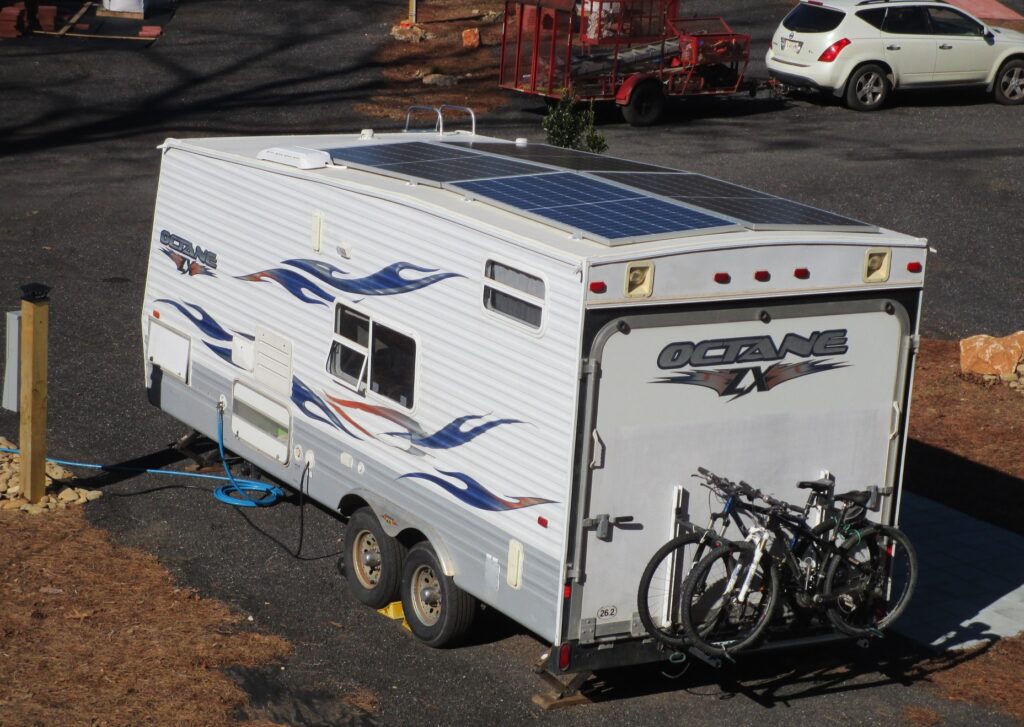
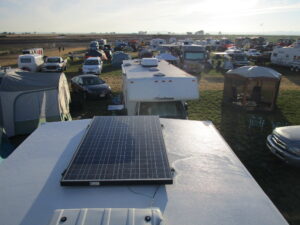
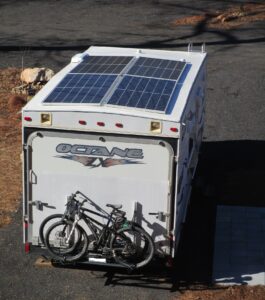

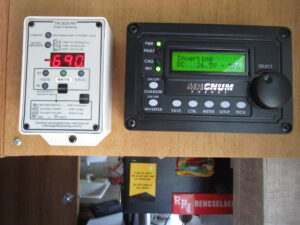
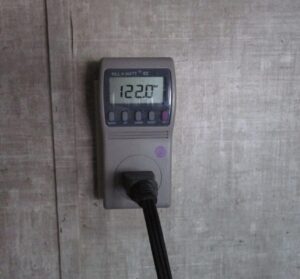
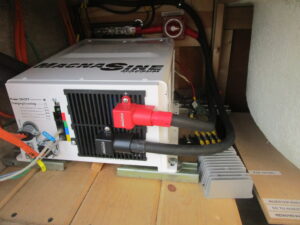

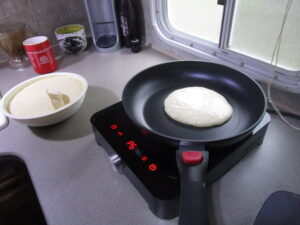
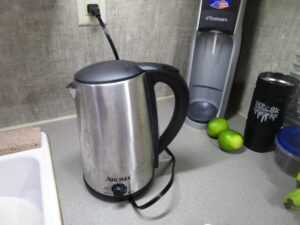
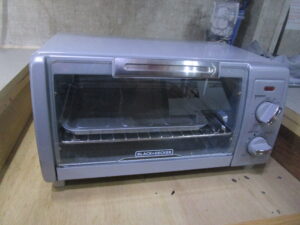

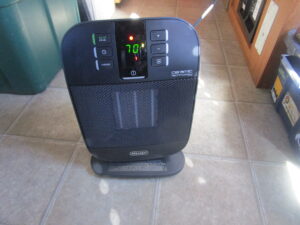

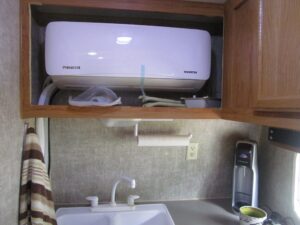
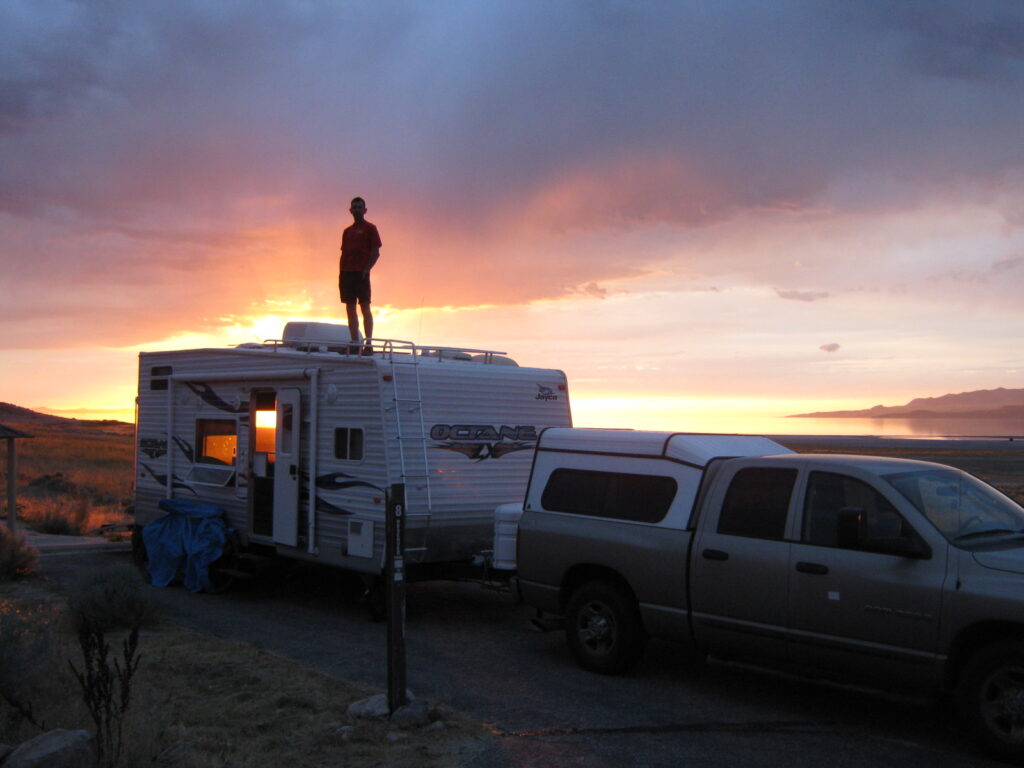
Excellent, thank you Marcy & John!!
Love the Howie sunste picture!!
Thank you Danny, I do too!
Living “Off Grid” is an experiment which tends to test the limits of your equipment.
On a mobile platform like an RV or Van, you’re trying for a balance of keeping the weight (of extra batteries and solar panels) down and having plenty of power. Yes, the fridge is a significant load, especially in hot weather because it needs to run all the time. Got to make sure your RV is well insulated. I believe the best way to reduce your demand for power is to optimize or eliminate as many HEATING devices as you can. I don’t know how practical this is on your RV, but if you could solar heat your domestic water with some kind of thermal collector (on the remain space on the roof?) you’d save a bunch of energy. Have you ever used one of those black solar shower bags when primitive camping? They can get quite hot if you don’t mind using hot water when it is Sunny and warmer outside?
Hi Marc! Thanks for the comments!
Our water heater load is manageable (400-500 Wh to heat water enough to shower), but it would be great if we could whittle it down a bit. We do indeed have a solar shower that we could fill and lay up on the roof. We’ve used it for off-grid stints in the past, and it’s a good suggestion that we bring it back out to play with again. It also reduces water usage when we’re off-grid. I’ll add it to our list of things to experiment with this summer.
Thanks again!
-Marcy
Marc beat me to it; solar heating of water with a black bag or even a larger trough could be (?) much more efficient – solar panels are 20% efficient at best; I can’t find efficiency info on passive water heating, but intuition is that it’s quite a bit more. That might be an interesting experiment.
(stuff you probably know, but I’m in engineer-splainin’ mode):
w/r/t DC powering of a water heater, AC is quoted in “RMS” – “root of the mean of the square” – but it really means that 120VAC is power-delivered identical to 120V DC, all of the adjustments for a sine-wave have been calculated. (120VAC is really 170V from zero to peak, and 340V from the positive peak and negative peak). But for “slow” devices, like the resistive element in a water heater, RMS AC and plain ol’ DC are equivalent.
So. Your water heater is 1400W. That’s 120VAC at 12 amps, and implies a resistive element of 10 ohms. If you simply replaced the element’s power with 24V DC, you’d draw 2.4 amps, for 58W. It’d take 1400/58 = 24 hours to heat up on 24V DC power vs what would take 1 hour on 120VAC. Yikes. So a simple swap of power source isn’t practical; you’d need a dedicated device with much greater current draw.
Additionally, what’s the weight penalty? Water weighs a lot. Houses store a lot of hot water, or use instant heaters that take gobs of 240VAC power and glow like furnaces – you’ve neither huge storage or huge power. Could you consider a system that (when parked for multiple days) tanks a dozen or so gallons of water, and gradually, with a combination of solar and excess electrical, builds up a bank of hot water? Just like you chart the batteries, you could chart the temp and volume of hot water? Then when it’s time to move on, you dump most of the water/weight and start over at the next campsite?
And (down the rabbit hole we go) maybe take advantage of the unique aspects of being mobile? Your tow vehicle produces waste heat and excess energy – maybe add a dedicated radiator to the motor or exhaust, make hot water while you drive? And what about the energy from braking – similar to the various regenerative braking schemes in Formula One, or your run-of-the-mill Prius?
OK, two more “down the rabbit hole” ideas, both having to do with waste heat you’ll be generating, and if-how you can capture that to help knock the hot water load down. The heat pump that you’ll use for cooling the interior – where does it vent the hot side? Same for the ‘fridge – if it’s cold inside the fridge, it has to be hotter somewhere else. Can either of these be looped into heating water, either directly or with a heat exchanger?
As a curiosity, is the ‘fridge “traditional” (with compressor, freon, etc) or with thermo-electric cooling (TEC) modules. TECs are much less efficient, but they’ve no moving parts and negligible weight. I’ve seen both in mobile applications; TEC more common for “six pack”-sized applications, compressors for larger.
Hi Kurt! Thanks for your thoughts, and it has taken a while for us to go through everything 🙂
Yes, as I just commented to Marc, we’ll bring out the solar shower again, great idea.
Regarding a DC water heater, John has looked around a bit and found a replacement 900W heater element that runs on 24V. So it might take 30 minutes to heat water up to the “shower worthy” warm instead of 18 minutes now, but certainly within the realm of feasible. Removing the inverter efficiency loss should be helpful to reduce total energy draw. And it’s a direct replacement element that works with our current water heater, not much $ and looks to be a straightforward swap. Also, controlling the water temperature would be an energy saver. We’ll likely start working on all that this summer.
Regarding the other ideas, we don’t use much hot water; so besides the solar shower and DC water heater, it’s not something we’re going to put too much focus on for the foreseeable future. But it’s fun to hear all the things you came up with!
A couple comments – while we are driving a diesel truck right now, we’re hoping to be driving an EV truck (next year??), so there won’t be enough excess heat from that source. Waste heat from the heat pump/fridge – maybe? John is taking that under consideration. Yes, our fridge runs on a compressor; we haven’t heard about TEC but we might be fridge shopping soon, so we’ll take a look…
Thanks again!
-Marcy